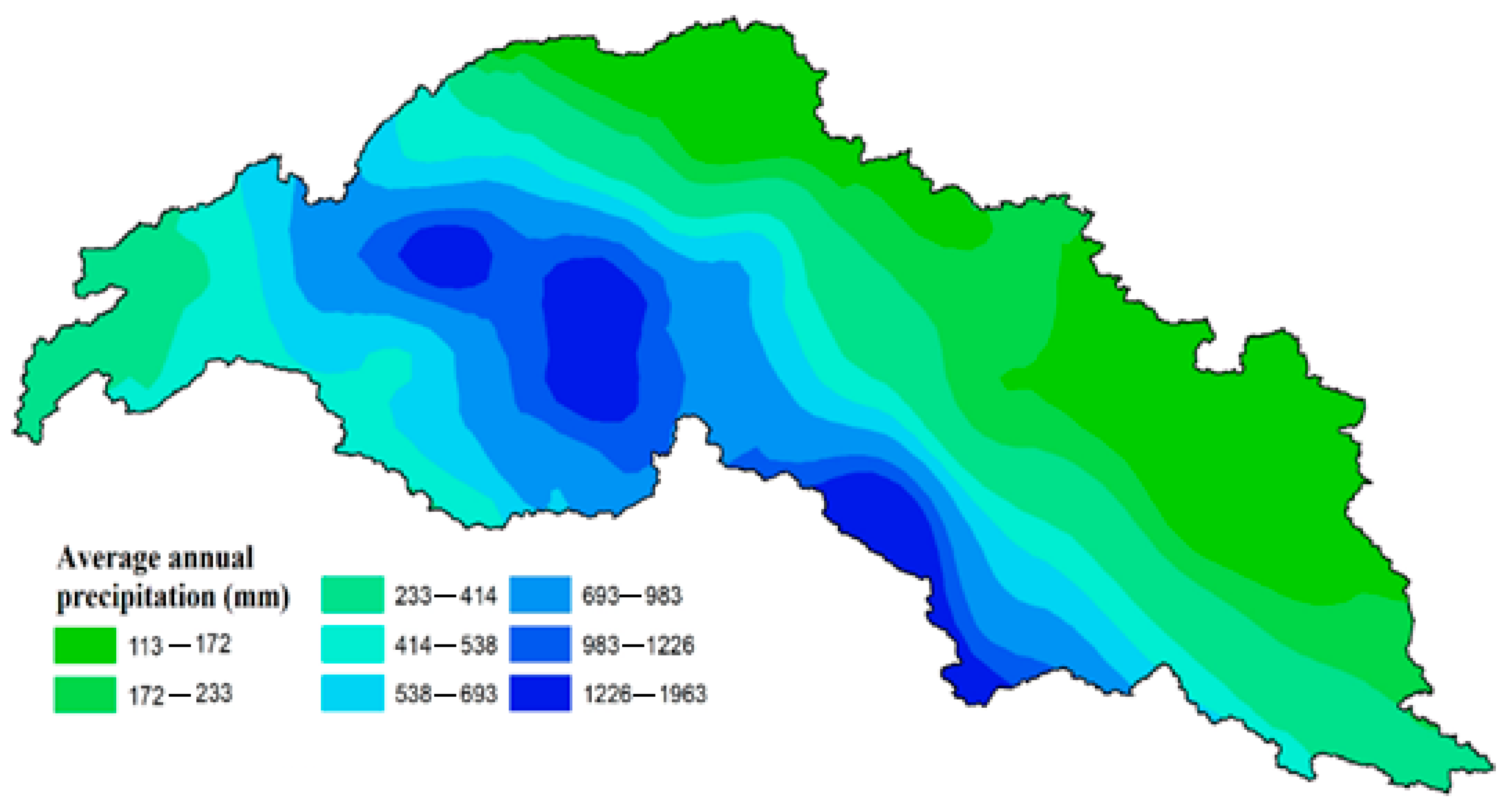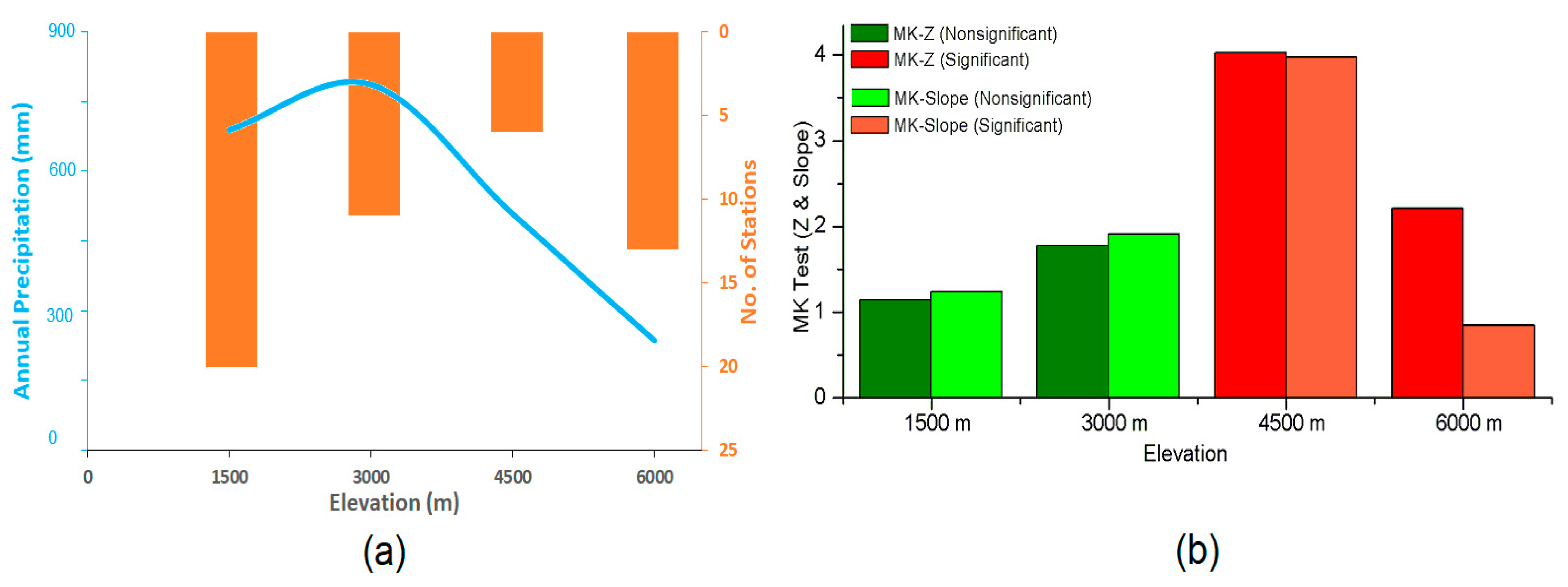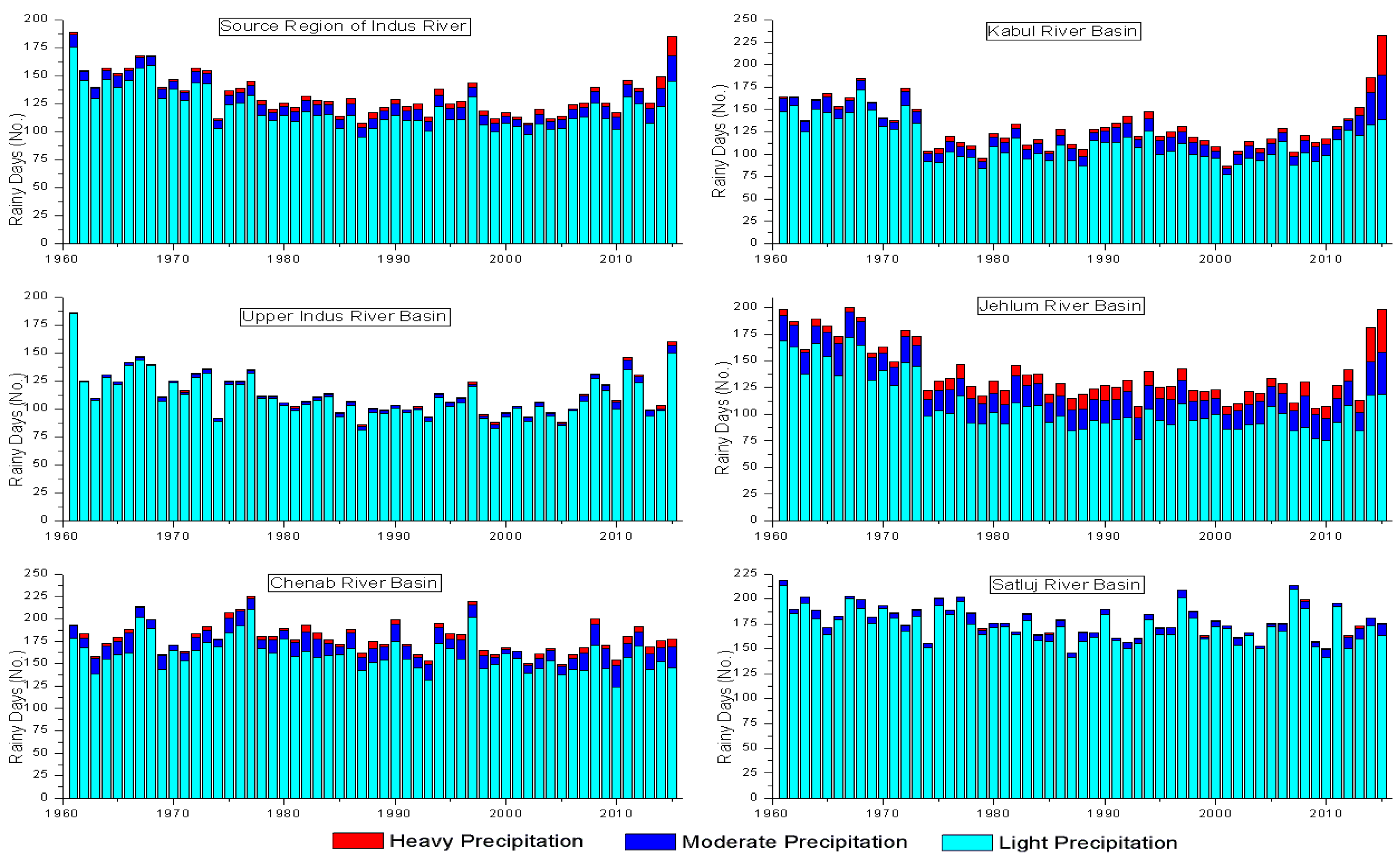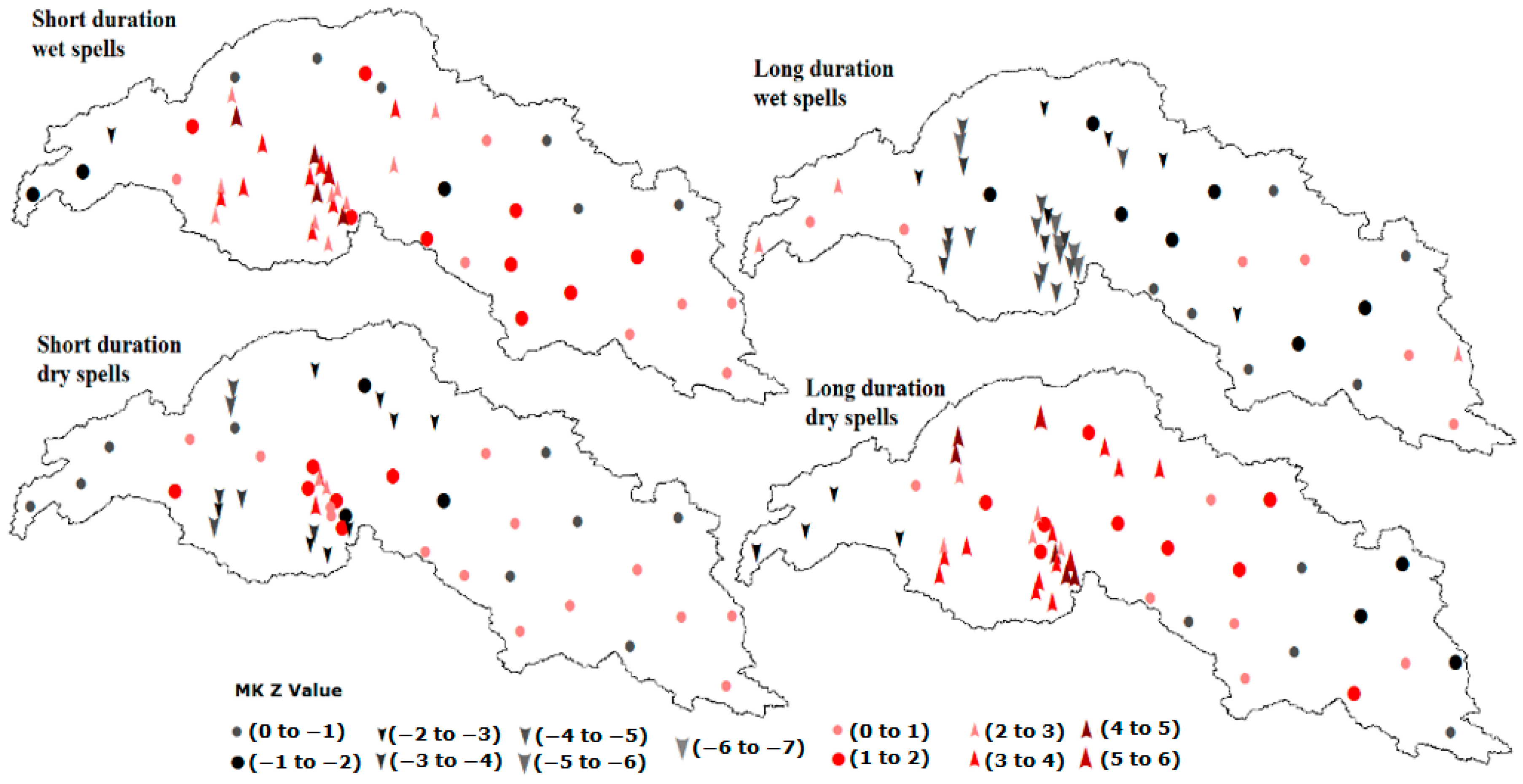Precipitation Variations under a Changing Climate from 1961–2015 in the Source Region of the Indus River
Abstract
:1. Introduction
2. Materials and Methods
2.1. Study Area
2.2. Data Collection
2.3. APHRODITE Precipitation Data
2.4. Selection of Climatic Variables
2.5. Trend Analysis
2.5.1. Mann-Kendall Trend Analysis Test
2.5.2. Sen’s Slope Test
3. Results and Discussion
3.1. Evaluation of the APHRODITE Precipitation Data
3.2. Spatial Distribution of Annual Precipitation Amounts
3.3. Trends in Annual Precipitation, Seasonal Precipitation, and Rainy Days
3.4. Characteristics of Different Precipitation Classes
3.5. Trend Analysis of Wet and Dry Spells
4. Conclusions
Author Contributions
Funding
Acknowledgments
Conflicts of Interest
References
- Ojeh, E. Hydrology of the Indus Basin (Pakistan). 2006. Available online: https://waterinfo.net.pk/sites/default/files/knowledge/Hydrology%20of%20the%20Indus%20Basin.pdf (accessed on 10 February 2019).
- Hasson, S.U.; Böhner, J.; Lucarini, V. Prevailing climatic trends and runoff response from Hindukush–Karakoram–Himalaya, upper Indus Basin. Earth Syst. Dyn. 2017, 8, 337–355. [Google Scholar] [CrossRef]
- Lutz, A.F.; Lutz, A.; Immerzeel, W.W.; Kraaijenbrink, P.D.A.; Shrestha, A.B.; Bierkens, M.F.P. Climate Change Impacts on the Upper Indus Hydrology: Sources, Shifts and Extremes. PLOS ONE 2016, 11, e0165630. [Google Scholar] [CrossRef] [PubMed]
- Immerzeel, W.W.; Van Beek, L.P.H.; Bierkens, M.F.P. Climate Change Will Affect the Asian Water Towers. Science 2010, 328, 1382–1385. [Google Scholar] [CrossRef] [PubMed]
- Archer, D. Contrasting hydrological regimes in the upper Indus Basin. J. Hydrol. 2003, 274, 198–210. [Google Scholar] [CrossRef]
- Mukhopadhyay, B.; Khan, A. A quantitative assessment of the genetic sources of the hydrologic flow regimes in Upper Indus Basin and its significance in a changing climate. J. Hydrol. 2014, 509, 549–572. [Google Scholar] [CrossRef]
- Bookhagen, B.; Burbank, D.W. Toward a complete Himalayan hydrological budget: Spatiotemporal distribution of snowmelt and rainfall and their impact on river discharge. J. Geophys. Res. Space Phys. 2010, 115, 1–25. [Google Scholar] [CrossRef]
- Immerzeel, W.W.; Pellicciotti, F.; Bierkens, M.F.P.; Immerzeel, W. Rising river flows throughout the twenty-first century in two Himalayan glacierized watersheds. Nat. Geosci. 2013, 6, 742–745. [Google Scholar] [CrossRef]
- Immerzeel, W.W.; Pellicciotti, F.; Shrestha, A.B. Glaciers as a Proxy to Quantify the Spatial Distribution of Precipitation in the Hunza Basin. Mt. Res. Dev. 2012, 32, 30–38. [Google Scholar] [CrossRef]
- Dimri, A.P.; Chevuturi, A. Model sensitivity analysis study for western disturbances over the Himalayas. Meteorol. Atmos. Phys. 2014, 123, 155–180. [Google Scholar] [CrossRef]
- Dimri, A.; Yasunari, T.; Wiltshire, A.; Kumar, P.; Mathison, C.; Ridley, J.; Jacob, D. Application of regional climate models to the Indian winter monsoon over the western Himalayas. Sci. Total. Environ. 2013, 468, S36–S47. [Google Scholar] [CrossRef]
- Kwarteng, A.Y.; Dorvlo, A.S.; Kumar, G.T.V. Analysis of a 27-year rainfall data (1977–2003) in the Sultanate of Oman. Int. J. Clim. 2009, 29, 605–617. [Google Scholar] [CrossRef]
- Lazaro, R.; Rodrigo, F.S.; Gutiérrez, L.; Domingo, F.; Puigdefàbregas, J. Analysis of a 30-year rainfall record (1967–1997) in semi–arid SE Spain for implications on vegetation. J. Arid. Environ. 2001, 48, 373–395. [Google Scholar] [CrossRef]
- Trenberth, K.E. Changes in precipitation with climate change. Clim. Res. 2011, 47, 123–138. [Google Scholar] [CrossRef] [Green Version]
- Wu, P.; Christidis, N.; Stott, P. Anthropogenic impact on Earth’s hydrological cycle. Nat. Clim. Chang. 2013, 3, 807–810. [Google Scholar] [CrossRef]
- Abbas, F.; Ahmad, A.; Safeeq, M.; Ali, S.; Saleem, F.; Hammad, H.M.; Farhad, W. Changes in precipitation extremes over arid to semiarid and subhumid Punjab, Pakistan. Theor. Appl. Clim. 2013, 116, 671–680. [Google Scholar] [CrossRef]
- Pal, I.; Al-Tabbaa, A. Assessing seasonal precipitation trends in India using parametric and non-parametric statistical techniques. Theor. Appl. Climatol. 2011, 103, 1–11. [Google Scholar] [CrossRef]
- Chen, P.-C.; Wang, Y.-H.; You, G.J.-Y.; Wei, C.-C. Comparison of methods for non-stationary hydrologic frequency analysis: Case study using annual maximum daily precipitation in Taiwan. J. Hydrol. 2017, 545, 197–211. [Google Scholar] [CrossRef]
- Gajbhiye, S.; Meshram, C.; Singh, S.K.; Srivastava, P.K.; Islam, T. Precipitation trend analysis of Sindh river basin, India, from 102-year record (1901–2002). Atmos. Sci. Lett. 2016, 17, 71–77. [Google Scholar] [CrossRef]
- Knowles, N.; Dettinger, M.D.; Cayan, D.R. Trends in Snowfall versus Rainfall in the Western United States. J. Clim. 2006, 19, 4545–4559. [Google Scholar] [CrossRef] [Green Version]
- Callaghan, T.V.; Johansson, M.; Brown, R.D.; Groisman, P.Y.; Labba, N.; Radionov, V.; Bradley, R.S.; Blangy, S.; Bulygina, O.N.; Christensen, T.R.; et al. Multiple Effects of Changes in Arctic Snow Cover. Ambio 2011, 40, 32–45. [Google Scholar] [CrossRef] [Green Version]
- Llano, M.P.; Penalba, O.C. A climatic analysis of dry sequences in Argentina. Int. J. Clim. 2011, 31, 504–513. [Google Scholar] [CrossRef]
- Panagoulia, D.; Vlahogianni, E.I. Nonlinear dynamics and recurrence analysis of extreme precipitation for observed and general circulation model generated climates. Hydrol. Process. 2014, 28, 2281–2292. [Google Scholar] [CrossRef]
- Panagoulia, D.; Vlahogianni, E.I. Recurrence quantification analysis of extremes of maximum and minimum temperature patterns for different climate scenarios in the Mesochora catchment in Central-Western Greece. Atmos. Res. 2018, 205, 33–47. [Google Scholar] [CrossRef]
- Abbas, F.; Rehman, I.; Adrees, M.; Ibrahim, M.; Saleem, F.; Ali, S.; Rizwan, M.; Salik, M.R. Prevailing trends of climatic extremes across indus-delta of Sindh-Pakistan. Theor. Appl. Climatol. 2018, 131, 1101–1117. [Google Scholar] [CrossRef]
- Balling, R.C.; Kiany, M.S.K.; Roy, S.S. Anthropogenic signals in Iranian extreme temperature indices. Atmos. Res. 2016, 169, 96–101. [Google Scholar] [CrossRef]
- Yao, J.; Chen, Y. Trend analysis of temperature and precipitation in the Syr Darya Basin in Central Asia. Theor. Appl. Climatol. 2015, 120, 521–531. [Google Scholar] [CrossRef]
- Houze, R.A.; Rasmussen, K.L.; Medina, S.; Brodzik, S.R.; Romatschke, U. Anomalous Atmospheric Events Leading to the Summer 2010 Floods in Pakistan. Bull. Am. Meteorol. Soc. 2011, 92, 291–298. [Google Scholar] [CrossRef]
- Li, X.; Cheng, G.; Lin, H.; Cai, X.; Fang, M.; Ge, Y.; Hu, X.; Chen, M.; Li, W. Watershed System Model: The Essentials to Model Complex Human-Nature System at the River Basin Scale. J. Geophys. Res. Atmos. 2018, 123, 3019–3034. [Google Scholar] [CrossRef]
- Lutz, A.F.; Immerzeel, W.W.; Shrestha, A.B.; Bierkens, M.F.P.; Lutz, A.; Immerzeel, W. Consistent increase in High Asia’s runoff due to increasing glacier melt and precipitation. Nat. Clim. Chang. 2014, 4, 587–592. [Google Scholar] [CrossRef]
- Immerzeel, W.W.; Bierkens, M.F.P. Asia’s water balance. Nat. Geosci. 2012, 5, 841. [Google Scholar] [CrossRef]
- Bajracharya, S.R.; Shrestha, B.R. The Status of Glaciers in the Hindu Kush-Himalayan Region; International Centre for Integrated Mountain Development (ICIMOD): Kathmandu, Nepal, 2011. [Google Scholar]
- UNEP (United Nations Environment Programme). Recent Trends in Melting Glaciers, Tropospheric Temperatures over the Himalayas and Summer Monsoon Rainfall Over India; Division of Early Warning and Assessment Nairobi: Nairobi, Kenya, 2009. [Google Scholar]
- Zonn, I.S. Water resources of Northern Afghanistan and Their Future Use. Unpublished Paper Prepared for Meeting. 2002. Available online: http://www.cawater-info.net/afghanistan/pdf/zonn.pdf (accessed on 21 February 2019).
- Hewitt, K. The Karakoram Anomaly? Glacier Expansion and the ‘Elevation Effect,’ Karakoram Himalaya. Mt. Res. Dev. 2005, 25, 332–340. [Google Scholar] [CrossRef]
- Yao, T.; Thompson, L.; Yang, W.; Yu, W.; Gao, Y.; Guo, X.; Yang, X.; Duan, K.; Zhao, H.; Xu, B.; et al. Different glacier status with atmospheric circulations in Tibetan Plateau and surroundings. Nat. Clim. Chang. 2012, 2, 663–667. [Google Scholar] [CrossRef]
- Tahir, A.A.; Chevallier, P.; Arnaud, Y.; Neppel, L.; Ahmad, B. Modeling snowmelt-runoff under climate scenarios in the hunza river basin, Karakoram range, Northern Pakistan. J. Hydrol. 2011, 409, 104–117. [Google Scholar] [CrossRef]
- Yuan, F.; Berndtsson, R.; Zhang, L.; Uvo, C.B.; Hao, Z.; Wang, X.; Yasuda, H. Hydro Climatic Trend and Periodicity for the Source Region of the Yellow River. J. Hydrol. Eng. 2015, 20, 5015003. [Google Scholar] [CrossRef]
- Hu, Y.; Maskey, S.; Uhlenbrook, S. Trends in temperature and rainfall extremes in the yellow river source region, China. Clim. Chang. 2012, 110, 403–429. [Google Scholar] [CrossRef]
- Iqbal, M.; Wen, J.; Wang, S.; Tian, H.; Adnan, M. Variations of precipitation characteristics during the period 1960–2014 in the Source Region of the Yellow River, China. J. Arid. Land 2018, 10, 388–401. [Google Scholar] [CrossRef]
- Gong, D.-Y.; Shi, P.-J.; Wang, J.-A. Daily precipitation changes in the semi-arid region over northern China. J. Arid. Environ. 2004, 59, 771–784. [Google Scholar] [CrossRef]
- Mukherjee, S.; Ballav, S.; Soni, S.; Kumar, K.; De, U.K. Investigation of dominant modes of monsoon ISO in the Northwest and eastern Himalayan region. Theor. Appl. Climatol. 2016, 125, 489–498. [Google Scholar] [CrossRef]
- Wang, S.; Ding, Y.; Iqbal, M. Defining Runoff Indices and Analyzing Their Relationships with Associated Precipitation and Temperature Indices for Upper River Basins in the Northwest Arid Region of China. Water. 2017, 9, 618. [Google Scholar] [CrossRef]
- Mavromatis, T.; Stathis, D. Response of the water balance in Greece to temperature and precipitation trends. Theor. Appl. Climatol. 2011, 104, 13–24. [Google Scholar] [CrossRef]
- Birsan, M.V.; Molnar, P.; Burlando, P.; Pfaundler, M. Streamflow trends in Switzerland. J. Hydrol. 2005, 314, 312–329. [Google Scholar] [CrossRef]
- Norrant, C.; Douguédroit, A. Monthly and daily precipitation trends in the Mediterranean (1950–2000). Theor. Appl. Climatol. 2006, 83, 89–106. [Google Scholar] [CrossRef]
- Hamed, K.H. Trend detection in hydrologic data: The Mann–Kendall trend test under the scaling hypothesis. J. Hydrol. 2008, 349, 350–363. [Google Scholar] [CrossRef]
- Amin, M.T.; Rizwan, M.; Alazba, A.A. A best-fit probability distribution for the estimation of rainfall in northern regions of Pakistan. Open Life Sci. 2016, 11, 432–440. [Google Scholar] [CrossRef]
- David, M. Geostatistical Ore Reserve Estimation; Elsevier: Amsterdam, the Netherlands, 2012. [Google Scholar]
- Tabios, G.Q.; Salas, J.D. A comparative analysis of techniques for spatial interpolation of precipitation. JAWRA J. Am. Water Resour. Assoc. 1985, 21, 365–380. [Google Scholar] [CrossRef]
- Phillips, D.L.; Dolph, J.; Marks, D. A comparison of geostatistical procedures for spatial analysis of precipitation in mountainous terrain. Agric. For. Meteorol. 1992, 58, 119–141. [Google Scholar] [CrossRef]
- Khattak, M.; Babel, M.; Sharif, M. Hydro-meteorological trends in the upper Indus River basin in Pakistan. Clim. Res. 2011, 46, 103–119. [Google Scholar] [CrossRef]
- Yan, L.; Liu, X. Has climatic warming over the Tibetan plateau paused or continued in recent years? J. Earth Ocean Atmos. Sci. 2014, 1, 13–28. [Google Scholar]
- Duhan, D.; Pandey, A. Statistical analysis of long term spatial and temporal trends of precipitation during 1901–2002 at Madhya Pradesh, India. Atmos. Res. 2013, 122, 136–149. [Google Scholar] [CrossRef]
- Wen, X.; Wu, X.; Gao, M. Spatiotemporal variability of temperature and precipitation in Gansu Province (Northwest China) during 1951–2015. Atmos. Res. 2017, 197, 132–149. [Google Scholar] [CrossRef]
- Khattak, M.S.; Khan, A.; Alam Khan, M.; Ahmad, W.; Rehman, S.U.; Sharif, M.; Ahmad, S. Investigation of Characteristics of Hydrological Droughts in Indus Basin. Sarhad J. Agric. 2019, 35, 48–56. [Google Scholar] [CrossRef]
- Ahmad, I.; Zhang, F.; Tayyab, M.; Anjum, M.N.; Zaman, M.; Liu, J.; Farid, H.U.; Saddique, Q. Spatiotemporal analysis of precipitation variability in annual, seasonal and extreme values over upper Indus River basin. Atmos. Res. 2018, 213, 346–360. [Google Scholar] [CrossRef]
- De Groeve, T.; Kugler, Z.; Brakenridge, G.R. Near real time flood alerting for the global disaster alert and coordination system. In Proceedings ISCRAM2007; De Groeve, T., Kugler, Z., Brakenridge, G.R., Eds.; VUBPRESS Brussels University Press: Brussels, Belgium, 2006; pp. 33–39. [Google Scholar]
- Jabeen, S.; Ashfaq, M.; AHMAD-BAIG, I. Linear program modeling for determining the value of irrigation water. J. Agric. Soc. Sci. 2006, 2, 101–105. [Google Scholar]










| Statistical Indices | Results of Statistical Indices | ||
|---|---|---|---|
| Minimum | Maximum | Average | |
| CC | 0.3 | 0.9 | 0.7 |
| SE | 0.3 | 3.3 | 1.8 |
| IOA | 0.5 | 0.9 | 0.8 |
| Bias | −19.2 | 20.2 | 2.3 |
| RMSE | 1.2 | 8.7 | 5.9 |
| Basin | Light Precipitation | Moderate Precipitation | Heavy Precipitation | |||
|---|---|---|---|---|---|---|
| Z | Q | Z | Q | Z | Q | |
| SRIR | −2 * | −0.7 * | 1.9 | 0.5 | 3.4 * | 1.8 * |
| Kabul sub-basin | −0.3 | −0.2 | 1.6 | 0.7 | 3.9 * | 2.5 * |
| Upper Indus sub-basin | −0.5 | −0.1 | 3 * | 0.5 * | 3.1 * | 1.1 * |
| Jhelum sub-basin | −4.6 * | −2.7 * | 0.2 | 0.1 | 3 * | 5 * |
| Chenab sub-basin | −0.6 | −0.3 | 1.3 | 1 | 3.5 * | 3.2 * |
| Satluj sub-basin | −3.5 * | −1.9 * | 1.1 | 0.4 | 2.3 * | 0.2 * |
| River Basins | Precipitation Classes | Precipitation Contributions in Different Seasons (%) | |||
|---|---|---|---|---|---|
| Winter | Spring | Summer | Autumn | ||
| SRIR | Light | 45 | 46 | 46 | 55 |
| Moderate | 30 | 30 | 25 | 27 | |
| Heavy | 25 | 23 | 29 | 18 | |
| Kabul | Light | 42 | 42 | 49 | 56 |
| Moderate | 34 | 33 | 24 | 27 | |
| Heavy | 25 | 25 | 27 | 17 | |
| UIRB | Light | 70 | 59 | 64 | 70 |
| Moderate | 18 | 23 | 19 | 20 | |
| Heavy | 12 | 19 | 17 | 10 | |
| Jhelum | Light | 32 | 36 | 32 | 43 |
| Moderate | 33 | 36 | 26 | 34 | |
| Heavy | 35 | 29 | 42 | 23 | |
| Chenab | Light | 39 | 48 | 67 | 63 |
| Moderate | 35 | 31 | 24 | 26 | |
| Heavy | 26 | 21 | 10 | 12 | |
| Satluj | Light | 76 | 83 | 79 | 89 |
| Moderate | 21 | 15 | 16 | 8 | |
| Heavy | 3 | 2 | 5 | 3 | |
© 2019 by the authors. Licensee MDPI, Basel, Switzerland. This article is an open access article distributed under the terms and conditions of the Creative Commons Attribution (CC BY) license (http://creativecommons.org/licenses/by/4.0/).
Share and Cite
Rizwan, M.; Li, X.; Jamal, K.; Chen, Y.; Chauhdary, J.N.; Zheng, D.; Anjum, L.; Ran, Y.; Pan, X. Precipitation Variations under a Changing Climate from 1961–2015 in the Source Region of the Indus River. Water 2019, 11, 1366. https://doi.org/10.3390/w11071366
Rizwan M, Li X, Jamal K, Chen Y, Chauhdary JN, Zheng D, Anjum L, Ran Y, Pan X. Precipitation Variations under a Changing Climate from 1961–2015 in the Source Region of the Indus River. Water. 2019; 11(7):1366. https://doi.org/10.3390/w11071366
Chicago/Turabian StyleRizwan, Muhammad, Xin Li, Kashif Jamal, Yingying Chen, Junaid Nawaz Chauhdary, Donghai Zheng, Lubna Anjum, Youhua Ran, and Xiaoduo Pan. 2019. "Precipitation Variations under a Changing Climate from 1961–2015 in the Source Region of the Indus River" Water 11, no. 7: 1366. https://doi.org/10.3390/w11071366
APA StyleRizwan, M., Li, X., Jamal, K., Chen, Y., Chauhdary, J. N., Zheng, D., Anjum, L., Ran, Y., & Pan, X. (2019). Precipitation Variations under a Changing Climate from 1961–2015 in the Source Region of the Indus River. Water, 11(7), 1366. https://doi.org/10.3390/w11071366







